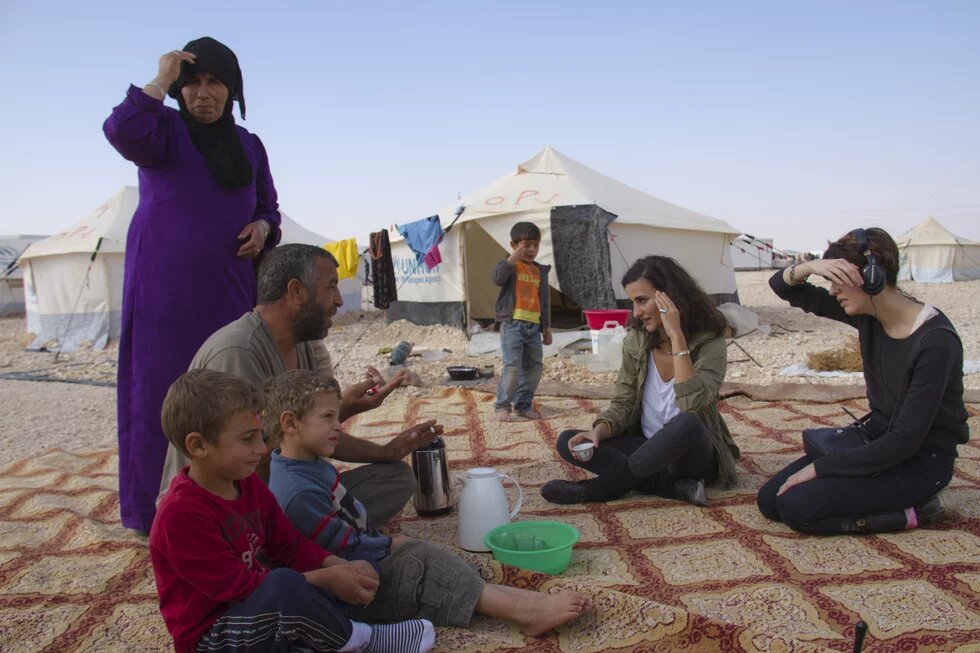

Written By: Claudia Lewis, Intern, Heinrich-Böll-Stiftung Palestine/Jordan
During a recent visit to Za’atari refugee camp in Jordan I had the opportunity to see part of the reality of the Syrian conflict at first hand, and to experience the unique and constantly evolving urban landscape of Za’atari camp. This landscape has changed dramatically since Dr René Wildangel, director of hbs Palestine/Jordan visited Za’atari in October 2012 just 3 months after it opened (his report can be read visit_zaatari_camp_.pdf). In more than a year that has passed, the refugee population in the camp has soared to over 100,000, so that the camp itself now encompasses 12 separate districts and is the fourth largest urban settlement in Jordan. The camp is located only 6 kilometres from the Syrian border and at moments, it was possible to hear mortar shells being dropped on the other side of the border.
Initially, the majority of refugees coming to the camp originated from Dera’a province close to the Jordanian border, an area that has been heavily bombed by the Syrian regime since the beginning of the conflict. Now refugees come from diverse regions, some travelling from as far away as Homs in central Syria. New refugees to the camp arrive at night and are picked up by the Jordanian army from the Syrian border after a dangerous trip lasting for many days and nights. According to UNHCR officials, the camp has at times received up to 2000 new refugees per day. In November 2013 ca. 300-400 refugees arrived per day, the majority of whom were women and children. The absence of male refugees was striking.
Living conditions in the camp vary starkly between the districts. Those districts close to the entrance, districts 1 and 2 established in 2012, are known as the ‘old city’. These areas benefit from being close to services such as schools and hospitals. However, they are also some of the most densely populated areas. Moreover, the ground there has not been gravelled as this was undertaken by UNHCR at the end of 2012 after districts 1 and 2 were already established. As a result, the refugees in these districts live in dust, which quickly turns to mud when it rains. Districts further from the entrance, such as District 8 and 9, feel very far from the main shopping street – commonly known as the “SHAMS-Elysées” in cynical reference to the Parisian luxury avenue – and from schools and other services. We carried out interviews in Districts 8 and 9, next to large stagnant pools of sewage.
Three schools have been established by UNICEF in order to provide education to the approximately 54,000 children living in the camp. Boys go to school in the morning and girls in the afternoon. The teachers at the schools are Jordanian because it is not permitted for Syrians, however well-qualified they might be, to have jobs in the camp as they do not have Jordanian work permits. Moreover, a bureaucratic problem has resulted in the Ministry of Education not having paid Jordanian teachers’ salaries in the camp for the last two months. Consequently, many teachers were on strike. The teachers who were present in the school struggled to maintain order amongst unruly children, not helped by the absence of basic teaching equipment including pens, once again due to a bureaucratic problem in the Ministry of Education.
The chaotic schooling and lack of other activities has lead to countless bored teenagers and younger children. Many boys carried slingshots with them and regularly catapulted stones at passing UN vehicles or other targets of curiosity such as foreign film teams. Crime in the camp was immediately evident, from the smuggled products in the main shopping street, to the bundles of electrical wires running overhead stealing electricity from the Jordanian providers. According to UNHCR, the lack of policing in the camp has lead to a burgeoning of local mafias and gangs. Trading of food ration cards on the black market is rife, and the cancellation of 20,000 ration cards by UNHCR for this reason lead to the World Food Program being mobbed by 700 angry refugees.
Although hardship prevails in Za’atari, the entrepreneurship and resilience shown by the refugees was inspiring. Following the fall of Quseir, a strategic town on the Syrian-Lebanese border, many refugees realized that they were going to be in Za’atari for the foreseeable future (the average life span for a UNHCR refugee camp is 10-12 years). As such, the refugees started to make improvements to their living spaces: people have started planting small gardens, owning pets, and even arranging their tents around fountains, as would be the structure of a traditional Damascene house.
Killian Kleinschmidt, the manager of the UNHCR team working in the camp, spoke of how he aims to turn the camp into a city as rapidly as possible, with refugees investing in their living space, buying their own provisions, and paying electricity and water bills. The word ‘city’, however, is not well-received by the Jordanian authorities. There are approximately 100,000 refugees in Za’atari camp and UNHCR have built a new camp in nearby Azraq in order to deal with the thousands more they expect to arrive in the coming months and years. Moreover, a further 500,000 Syrian refugees are living elsewhere in Jordan, in cities and villages. Tensions between the Jordanian security services policing the perimeter of the camp and the UNHCR team working to create a city for the refugees were evident. Reports of violence between Jordanian police and Syrian refugees are frequent. The parallels between the Palestinian refugee crisis and the Syrian refugee crisis, and the effect they have had on Jordan were uppermost in my mind. Whilst watching busloads of new refugees arriving, disoriented, hungry, and desperate, the Jordanian manager in charge of overseeing new arrivals said, “It’s like 1948 all over again”.
Contact: claudiaroselewis@gmail.com

